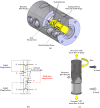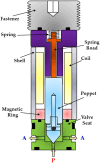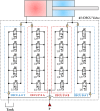Digital hydraulic valves: Advancements in research
- PMID: 38495130
- PMCID: PMC10943355
- DOI: 10.1016/j.heliyon.2024.e27264
Digital hydraulic valves: Advancements in research
Abstract
Despite the great advantages it offers, such as high-power density, precise control and large force output, conventional hydraulic valve control suffers from low energy efficiency due to substantial energy losses that occurs as the pressurized oil flows through the hydraulic circuit and its components, particularly the control-ones. Conventional hydraulic technology typically utilizes analogue spool valves, such as proportional and servovalves, as control components in various industrial and aeronautical applications where high precision and fast response are required. However, the use of these valves leads to high power dissipation, caused by the significant pressure drop across the small narrow passages uncovered during valve control. To maintain the relevance of hydraulic technology across industries, researchers are investigating a novel research field, also referred to as digital hydraulic technology. By using some digital concepts into hydraulic technology, the goal of this innovative research field is to replace conventional analogue spool valves with robust and low-cost digital On/Off valves, thus minimizing power losses and enhancing the overall efficiency of hydraulic systems. This paper presents a thorough review of the research advancements in digital hydraulic technology, with a specific focus on valve control. Firstly, the standard definition of digital hydraulic technology and its two main categories are introduced. Then, the operating principles and the digital approaches used to control digital hydraulic valves are examined. Afterwards, the digital hydraulic valve architectures developed over the years are reviewed, along with an in-depth analysis of their performance. Finally, the potential application scenarios, advantages and challenges with digital hydraulic valves are explored, highlighting potential areas for future research and development.
© 2024 The Authors.
Conflict of interest statement
The authors declare that they have no known competing financial interests or personal relationships that could have appeared to influence the work reported in this paper.
Figures






































References
-
- Mays L.W. Environmental Fluid Mechanics; 2008. A Very Brief History of Hydraulic Technology during Antiquity; pp. 471–484. - DOI
-
- Papoutsidakis M., Chatzopoulos A., Papachristos D., Drosos C. Hydraulics and pneumatics: operational characteristics and control for modern industry applications. Int. J. Comput. Appl. Jun. 2019;178(25):31–40. doi: 10.5120/ijca2019919049. - DOI
-
- Mokyr J., et al. 2000. Knowledge, Technology, and Economic Growth during the Industrial Revolution.
-
- El-Din M.G., Rabi M. first ed. McGraw-Hill Education; New York: 2009. Fluid Power Engineering.https://www.accessengineeringlibrary.com/content/book/9780071622462 [Online]. Available:
-
- Moog . 2003. Proportional and Servo Valve Technology.
Publication types
LinkOut - more resources
Full Text Sources

